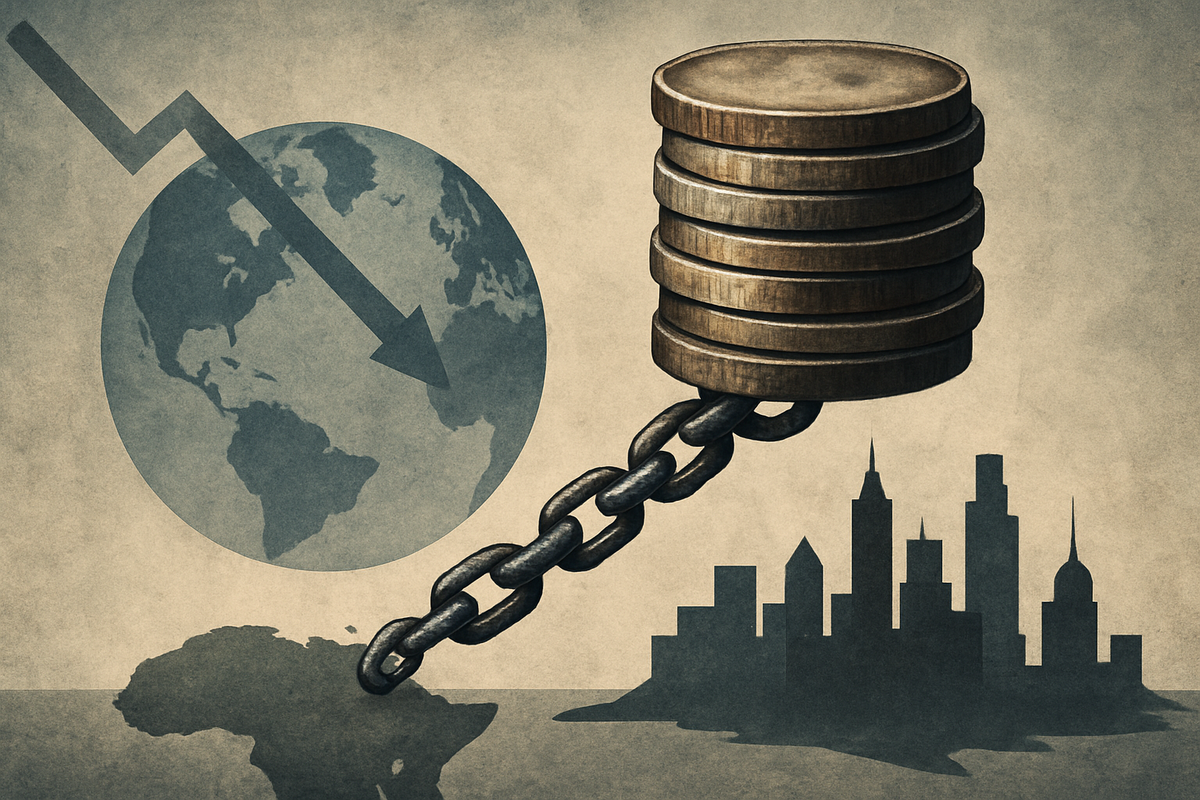
The International Monetary Fund (IMF) has issued a stark warning regarding the global economic outlook, projecting a deceleration in growth coupled with an alarming rise in debt risks for developing economies. This pronouncement, a consistent theme across its recent World Economic Outlook (WEO) and Fiscal Monitor reports, paints a challenging picture for the global financial landscape, signaling potential instability and constrained policy space for nations already grappling with economic headwinds. The immediate implications are significant, suggesting a period of increased volatility in financial markets and a re-evaluation of investment strategies, particularly concerning commodity-dependent nations and those with high debt burdens.
The IMF's assessment underscores a critical juncture for the world economy. While global growth projections for 2025 and 2026 have seen minor upward revisions from earlier pessimistic forecasts, they still represent a noticeable slowdown from previous years. This subdued outlook is primarily driven by persistent inflation, restrictive monetary policies in advanced economies, and a fading of temporary economic supports. For developing economies, the situation is particularly precarious, as they face the dual challenge of weaker global demand impacting their exports and the crushing weight of rising public debt, threatening to trigger a "fiscal-financial doom loop" that could destabilize the international monetary system.
A Looming Debt Storm and Decelerating Growth
The IMF's latest assessments, including those from its October 2025 and April 2025 World Economic Outlook and Fiscal Monitor reports, highlight an ongoing and pressing concern rather than a past event. The Fund projects global economic expansion to gradually decelerate, with growth forecasts for 2025 hovering around 3.2% and 3.1% for 2026, a slowdown from an estimated 3.3% in 2024. This revision, while slightly up from earlier April 2025 predictions of 2.8% for 2025, still reflects a cautious outlook. Advanced economies, notably the United States, are expected to experience a significant cooling, with U.S. growth anticipated to fall from 2.8% in 2024 to 2.0% in 2025. Emerging market and developing economies are also projected to see growth ease to 4.2% in 2025, influenced by softer trade and commodity prices. Key factors contributing to this slowdown include the winding down of temporary supports, persistent service-sector inflation, and the lingering effects of tight monetary policies implemented globally to combat price pressures.
The timeline leading up to this moment has been characterized by a series of economic shocks and policy responses. The COVID-19 pandemic triggered unprecedented fiscal spending, followed by a surge in inflation that prompted aggressive interest rate hikes by central banks worldwide. These actions, while necessary to stabilize prices, have contributed to a significant increase in global public debt, which the IMF now forecasts to exceed 100% of global GDP by 2029 – a level not seen since World War II. Developing economies, in particular, have found themselves in a precarious position, with more than half of low-income countries either in or at high risk of debt distress. Their vulnerability is exacerbated by limited financing options, weaker institutional frameworks, and the rising cost of servicing debt as global interest rates remain elevated.
Key players involved in this unfolding scenario include the International Monetary Fund itself, acting as a global economic watchdog and lender of last resort. Developing economies, particularly those in sub-Saharan Africa, Latin America, and parts of Asia, are at the epicenter of the debt crisis. Major creditors, including China, multilateral development banks (like the World Bank), and private financial institutions, also play a critical role in debt restructuring and relief efforts. Initial market reactions have been cautious, with increased scrutiny on the fiscal health of vulnerable nations and a general flight to quality in asset markets. Investors are showing signs of "complacency," according to the IMF, potentially underestimating systemic risks from trade tensions and fiscal imbalances, which could lead to sharp market corrections.
Navigating the Headwinds: Winners and Losers in a Slowing World
The IMF's somber outlook on global growth and rising debt risks for developing economies will inevitably create a distinct divide between potential winners and losers in the financial markets. Companies with strong balance sheets, diversified revenue streams, and exposure to stable, high-growth sectors in advanced economies are likely to weather the storm more effectively, while those heavily reliant on commodity demand or exposed to fiscally vulnerable nations may face significant challenges.
Potential Losers:
- Commodity Producers: A slowdown in global growth directly translates to reduced demand for raw materials. Companies like BHP Group (ASX: BHP), Rio Tinto (ASX: RIO), and major oil and gas producers such as ExxonMobil (NYSE: XOM) and Shell (AMS: SHELL), could see downward pressure on commodity prices, impacting their revenues and profitability. Developing economies are often significant consumers of industrial commodities for infrastructure development, and their debt woes could further suppress this demand.
- Companies with Exposure to Developing Market Debt: Financial institutions and investment funds holding significant sovereign debt from developing nations face increased default risk. While specific public companies are less directly exposed to sovereign debt as their primary business, large banks with extensive international lending operations or asset managers with significant emerging market bond portfolios could see impairments.
- Infrastructure and Construction Companies in Developing Economies: Firms like China Communications Construction Company (SSE: 601800) or local construction giants heavily dependent on government-funded projects in developing countries may experience a slowdown in new contracts as fiscal space shrinks and debt servicing takes precedence.
- Export-Oriented Industries (reliant on developing market demand): Manufacturers of capital goods, technology, and consumer durables that primarily target emerging markets for growth could see reduced sales volumes as economic activity slows and consumer spending tightens in these regions.
Potential Winners (or those less impacted):
- Defensive Sectors: Companies in stable, non-cyclical sectors such as healthcare (e.g., Johnson & Johnson (NYSE: JNJ)), utilities (e.g., NextEra Energy (NYSE: NEE)), and consumer staples (e.g., Procter & Gamble (NYSE: PG)) typically perform better during economic downturns as demand for their products and services remains relatively inelastic.
- Technology Companies with Strong Cash Flows and Global Reach: While not entirely immune, large technology companies with diversified global revenue streams and strong recurring revenue models (e.g., cloud services from Microsoft (NASDAQ: MSFT) or Amazon (NASDAQ: AMZN)) may be more resilient, especially if their services offer efficiency gains for businesses.
- Companies in Advanced Economies with Strong Domestic Demand: Firms primarily serving robust domestic markets in advanced economies that are less exposed to the direct impacts of developing world debt crises might fare better.
- Gold and Other Safe-Haven Assets: In times of economic uncertainty and financial instability, investors often flock to safe-haven assets. Gold mining companies (e.g., Barrick Gold (NYSE: GOLD)) and other precious metal producers could see increased demand and higher prices for their products.
The overall impact on financial markets will be characterized by increased risk aversion, a potential re-pricing of risk in emerging markets, and a flight to quality. Companies with prudent financial management and strategic agility will be better positioned to navigate the challenging environment described by the IMF.
Broader Implications and Historical Parallels
The IMF's warning about slowing global growth and escalating debt risks for developing economies extends far beyond immediate market reactions, resonating with broader industry trends and carrying significant regulatory and policy implications. This event fits into a wider narrative of increasing economic fragmentation, geopolitical tensions, and the persistent challenge of fostering sustainable development in a complex global environment.
One major trend is the de-globalization or re-globalization debate. Heightened trade tensions, particularly between major economic blocs, contribute to policy uncertainty and can disrupt established supply chains, further dampening global growth prospects. The IMF explicitly identifies intensifying trade tensions as a significant downside risk. This shift could lead to more regionalized trade and investment flows, impacting multinational corporations and potentially altering the competitive landscape. For example, companies like Apple (NASDAQ: AAPL), which has historically relied on extensive global supply chains, are already exploring diversification strategies to mitigate geopolitical risks.
The ripple effects on competitors and partners are substantial. For instance, major trading partners of commodity-exporting developing economies, such as China (SSE: 601800) (a large consumer of raw materials), could see their own economic growth trajectories affected by reduced demand. Similarly, international banks that have lent to these developing nations could face increased credit risk, potentially impacting their profitability and capital adequacy. The interconnectedness of the global financial system means that a debt crisis in one region can quickly spread, creating systemic risks.
Regulatory and policy implications are profound. The IMF's call for urgent policy action, including rebuilding fiscal resilience and safeguarding financial stability, suggests a push for more stringent fiscal rules and debt management frameworks globally. There could be increased pressure on multilateral institutions to expand their lending capacities and facilitate debt restructuring efforts. Discussions around a new international debt architecture, potentially involving greater participation from private creditors and new mechanisms for orderly sovereign defaults, are likely to gain traction. Furthermore, national governments may implement protectionist measures or introduce capital controls to shield their economies from external shocks, which could further fragment global markets.
Historically, there are parallels to similar periods of global economic slowdowns and sovereign debt crises. The Latin American debt crisis of the 1980s and the Asian financial crisis of 1997-1998 serve as stark reminders of how quickly debt vulnerabilities can escalate into full-blown economic crises, leading to widespread austerity, social unrest, and significant market disruptions. More recently, the European sovereign debt crisis of 2010-2012 demonstrated the potential for a "fiscal-financial doom loop," where government debt concerns spill over into the banking sector, creating a self-reinforcing cycle of instability. The IMF's current warnings explicitly reference the risk of such a loop, indicating that lessons from these past events are highly relevant today. The key difference now is the sheer scale of global public debt and the added layer of geopolitical complexity.
The Path Forward: Navigating Uncertainty
Looking ahead, the global economy, as envisioned by the IMF, faces a period of heightened uncertainty, demanding strategic pivots and adaptive measures from governments, businesses, and investors alike. In the short term, the immediate focus will be on managing debt sustainability and mitigating the fallout from slowing growth. Developing economies will likely intensify efforts to secure debt relief or restructuring, potentially leading to complex negotiations with creditors including China, Paris Club members, and private bondholders. For financial markets, this could translate into continued volatility, with a premium placed on assets perceived as safe havens.
In the long term, the challenges are even more systemic. The IMF emphasizes the urgent need for governments to rebuild fiscal buffers, which will require difficult choices regarding public spending and taxation. Countries may need to prioritize "growth-friendly" public investments in areas like infrastructure, education, and green technologies, even as they rein in overall expenditures. This could open market opportunities for companies involved in sustainable development, renewable energy (e.g., NextEra Energy (NYSE: NEE)), and digital infrastructure, particularly if these investments are supported by international financing. However, companies heavily reliant on government contracts in fiscally constrained developing nations might face a lean period.
Potential strategic pivots for businesses include diversifying supply chains away from regions prone to geopolitical or economic instability, focusing on increasing efficiency and productivity to offset slower demand, and strengthening balance sheets to withstand economic shocks. For investors, the emerging market landscape will require a highly selective approach, distinguishing between countries with sound macroeconomic policies and those facing severe debt distress. Market opportunities may arise from undervalued assets in resilient sectors or economies that successfully implement structural reforms. Conversely, challenges will include navigating currency fluctuations, sovereign default risks, and potential capital controls.
Several scenarios could unfold. A "best-case" scenario might involve coordinated international efforts for debt relief and robust economic reforms in developing countries, leading to a gradual stabilization of growth and debt levels. A "worst-case" scenario could see multiple sovereign defaults, triggering a widespread financial crisis reminiscent of past events, severely disrupting global trade and investment. A more probable "middle-ground" scenario suggests a prolonged period of subdued growth, elevated debt, and regionalized crises, with some economies successfully navigating the challenges while others struggle.
A Critical Juncture for the Global Economy
The International Monetary Fund's recent warnings about slowing global growth and the escalating debt crisis in developing economies represent a critical juncture for the global financial system. The key takeaway is clear: the era of cheap money and unbridled expansion is giving way to a more constrained and challenging economic environment. The confluence of persistent inflation, restrictive monetary policies, and unprecedented levels of public debt, particularly in vulnerable nations, poses a significant threat to stability and sustainable development.
Moving forward, financial markets will operate under a cloud of increased uncertainty. Investors should anticipate continued volatility, with a heightened focus on sovereign risk, particularly in emerging markets. The "complacency" identified by the IMF serves as a crucial caution, suggesting that current asset valuations may not fully reflect the systemic risks at play. This implies a potential for sharp market corrections, especially if trade tensions escalate or if a major sovereign default occurs. Companies with strong fundamentals, robust cash flows, and diversified operations are likely to be more resilient, while those heavily exposed to commodity price fluctuations or fiscally weak economies may face significant headwinds.
The lasting impact of this period will depend heavily on the policy responses from governments and international institutions. A failure to address the debt crisis proactively and to implement credible fiscal consolidation plans could lead to a prolonged period of economic stagnation, social unrest, and increased geopolitical instability. Conversely, coordinated efforts towards debt restructuring, targeted fiscal reforms, and investments in growth-enhancing sectors could pave the way for a more resilient and equitable global economy.
Investors should watch closely for several key indicators in the coming months: progress on debt negotiations for vulnerable nations, the trajectory of inflation and interest rates in major advanced economies, any shifts in global trade policies, and the fiscal health reports of individual countries. The ability of developing economies to attract sustainable investment and implement structural reforms will be paramount. Ultimately, the IMF's warning is not just a forecast but a call to action, urging a collective response to safeguard the future of global prosperity.
This content is intended for informational purposes only and is not financial advice





